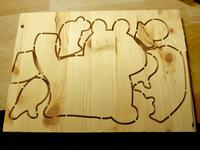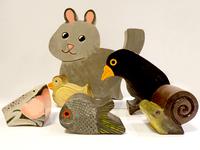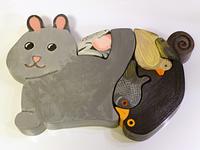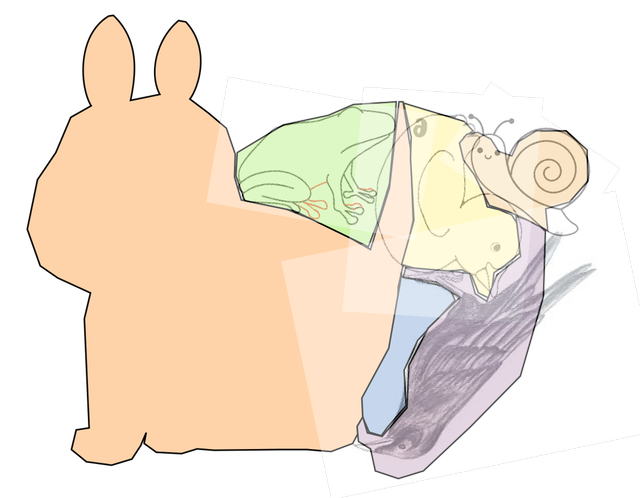Wooden animal puzzle
A classic wooden animal puzzle, CNC routed and hand-painted. This was a Christmas present to my newest nephew, half a year old. As such, I had to take into account some safety aspects also.
Design
I started the design by laying out a few animal images, trying to make them fit together snuggly. After several iterations, this is what I had:
Ok, so four reasonable animals plus one somewhat fish-shaped object plus one orange blob equals one bunny. That orange blob would definitely be the hardest, as its head would have to fit both for a bunny (formed by the completed puzzle) and some smaller animal. At this stage it was still undecided between cat, mouse and teddybear.
EN 71 standard
The EN 71 standard provides a surprisingly easy-to-read guide to kill.. keeping children safe with toys. Unfortunately it is paywalled, but can also be found with some creative googling. For this toy, I identified as relevant parts of the standard:
- Small parts cylinder (31.7 mm diameter, 25.4 mm to 57.1 mm sloped bottom). Objects that fit completely within this cylinder pose a suffocation hazard when swallowed.
- Geometric shape templates (50 mm by 35 mm oval, 42.7 mm circle, thickness of either is 30 mm). Objects that have parts that can protrude through such an opening cause a suffocation hazard if a small child falls face down on them. This only applies to children who cannot yet sit up on their own (younger than 9 months or so), but I chose to play it safe.
- Impact, torque, soaking tests. These just test that no small parts are produced when toys are thrown around.
Of these the small parts cylinder criteria are easy to meet just by scaling the parts up enough that they exceed the cylinder size. Such parts cannot fit completely in throat, so as long as they are not perfectly smooth balls or similar they are pretty safe.
However, the geometric shape test is more problematic. Here just having any thin part is enough to fail the toy. To have any hope of passing this, I had to make the puzzle out of 2x18 mm sheets, giving a total thickness of just over 36 mm. I then checked rest of the dimensions by making a 35x30 mm rectangle in Inkscape and trying to fit it over any protrusions. This required shortening and thickening the ears and tail of the proto-cat, making it more of a mouse. I guess it is reasonable for a toy standard to forbid cats.
Cutting it


Cutting out the parts was easy work for the CNC3020. I chose to also engrave some details on each side, to add nice surface feel and to help in painting them.
After gluing each piece together, there was some sanding to do. Especially as on the first sheet my clamping had failed and caused the pieces to move around a bit. Fortunately wood is very forgiving about small mistakes.
Painting and finishing touches



I hand-painted the pieces together with my wife, using some water-based acrylic paints. Took a lot of time, but such painting is actually a quite nice pastime. As I already had the images, I also cut out some simple acrylic stamps which were used to decorate the storage box.
Seeing it being tried out, it was a bit surprising how many tries even adults needed to get it assembled. The ability to flip each piece adds many degrees of freedom to assembling the puzzle.
The end result seems nice and durable. The extra thickness caused by the EN 71 geometric requirements actually turned out great also, as now each piece can stand up by its own, making them useful for all kinds of play apart from just being a puzzle.
If you are interested in duplicating this, here are the design files: top side, bottom side.
– Petteri Aimonen on 9.2.2016


